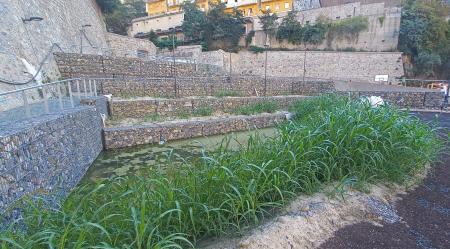
Area characterisation:
The Municipality of Genova has transformed the Gavoglio area in the Lagaccio district into a 10000 m2 urban park. The former military barracks in the area have been demolished and the area has developed into a public, inclusive and sustainable urban park built by almost entirely nature-based solutions. All functions of the park have been designed to be compatible with nature and the project involved the implementation of 12 different nature-based solutions.
Objective:
The city of Genoa experiences acute densification and lack of public green spaces, making urban heat stress a pronounced challenge. Air pollution and biodiversity loss are among the other challenges Genova targeted to address through NbS implementation.
Potential impacts/benefits:
The concentration levels of NO2 and O3 at the reference site in Via Napoli was significantly (1.5 to 3 times) greater than the one recorded in Gavoglio during the current data acquisition period, with a peak in autumn-winter time. Rain garden demonstrated the second high contribution to species diversity among all NbS implemented in the Gavoglio area. Survey among the stakeholders indicated that the largest number of respondents (55%) quantified the increase in values for residential properties between 6% and 10%. Approximately 4925 m3 of demolition materials were reused on site.
Actions:
The rain garden has been planned in a spot where there is a continuous water flow from natural slopes uphill. This spot also forms the lower point of the steeper part of the park, thus constituting a natural catchment point for rainwater runoff. Grasses have been selected to resist both flooding and protracted drought periods. Ideally, they will recreate a natural-like hygrophilous ecosystem with local species. Two willow trees were placed at the sides to provide shade and foster a moist environment. The most visited part was reinforced with a vegetated pave in order to allow grass to survive and to keep the ground plane and stable.
The vegetated grid pave, which is 108 m2, is composed of a PP/PEHD grid with an octagonal pattern that is filled with cultivation soil, allowing grass to grow. Beneath this layer is a sand substrate, a geomembrane, and, on a deeper level, a gravel substrate. The low-maintenance meadow, which measures 65m2, is composed of a seed mix with a prevalence of Cynodon dactilon and Festuca arundinacea, which are more resilient to drought periods. In the retention area, with a surface of 44 m2, a mix of Carex appressa, Carex elata, Echinacea purpurea, Juncus effusus, Iris japonica, and Iris pseudacorus, is set out in groups of 8/10 plants of each kind, with a distribution of 8 plants on each square meter. A biomat made of wood fibre and polypropylene net is used as mulching layer (45 m2).
Transferability of result:
Rain gardens are not restricted to certain climate zones, however the selected vegetation should be adapted to the local environmental and climate conditions. Rain gardens require space, selection of well-adapted plant species and semi-regular maintenance.
Lessons learnt:
Nature-based solutions offer an integrative direction for multidisciplinary cooperation, but the cooperation must be facilitated carefully. Citizens are willing to actively participate in co-creation and co-monitoring if tools and means of participant retention are carefully considered and applied.
Organisations:
City of Genova, https://smart.comune.genova.it/
LAND Italia, https://www.landsrl.com/
NBS goals:
- Enhancing sustainable urbanization
- Restoring ecosystems and their functions
- Developing climate change adaptation
- Improving risk management and resilience
- Urban regeneration through nature-based solutions
- Nature-based solutions for improving well-being in urban areas
- Multi-functional nature-based watershed management and ecosystem restoration
NBS benefits:
- Flood peak reduction
- Increase infiltration / Water storage
- Reduce flood risk
- Reduce run-off
- Improve connectivity and functionality of green and blue infrastructures
- Increase Biodiversity
- Increase quality and quantity of green and blue infrastructures
- Increase accessibility to green open spaces
- Increase amount of green open spaces for residents
- Increase awareness of NBS solution & their effectiveness and co benefits
- Increase well-being